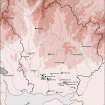Pricing Change
New pricing for orders of material from this site will come into place shortly. Charges for supply of digital images, digitisation on demand, prints and licensing will be altered.
Upcoming Maintenance
Please be advised that this website will undergo scheduled maintenance on the following dates:
Thursday, 9 January: 11:00 AM - 3:00 PM
Thursday, 23 January: 11:00 AM - 3:00 PM
Thursday, 30 January: 11:00 AM - 3:00 PM
During these times, some functionality such as image purchasing may be temporarily unavailable. We apologise for any inconvenience this may cause.
Dornock, St Marjory's Church
Architectural Fragment(S) (Period Unassigned), Burial Ground (Period Unassigned), Church (Period Unassigned), Grave Slab(S) (Medieval)
Site Name Dornock, St Marjory's Church
Classification Architectural Fragment(S) (Period Unassigned), Burial Ground (Period Unassigned), Church (Period Unassigned), Grave Slab(S) (Medieval)
Alternative Name(s) Dornock, Old Parish Church; Dornock Village; Dornock Parish Church And Churchyard
Canmore ID 67009
Site Number NY26NW 4.01
NGR NY 2304 6596
Datum OSGB36 - NGR
Permalink http://canmore.org.uk/site/67009
- Council Dumfries And Galloway
- Parish Dornock
- Former Region Dumfries And Galloway
- Former District Annandale And Eskdale
- Former County Dumfries-shire
NY26NW 4.01 2304 6596
(NY 23046596) St. Marjory's Church (NR) (Site of)
OS 6" map (1945)
The pre-Reformation church, traditionally dedicated to St. Marjory, was taken down when the present parish church (NY26NW 4.00) was built in 1793. It stood in the churchyard, about a chain south of, and immediately behind, the present church.
Name Book 1857
Three richly-carved coped stones, some 40 feet to the south of the east end of the parish church are said to mark the graves of the English commanders killed at the battle at Swordwell (NY26NW 3) and appear to be older than 1350. They are close to the spot where the east gable of the old church must have stood.
RCAHMS 1920; J Anderson 1875
Dornock (Glasgow, Annandale). A parsonage in Bagimond, the church remained unappropriated, although an attempt, apparently ineffective, was made to unite the church to Holmcultram by virtue of a grant made by Edward Baliol as King of Scots and confirmed to the abbey for twelve years by John, bishop of Glasgow (1333x35). The patronage of the church had passed to the earls of Douglas by the 15th century, but was granted in 1411 by Earl Archibald to Simon of Carruthers with whose family it remained until the early 16th century. It then passed, apparently by marriage, to the Carlyles of Torthorwald, with whom it remained at the Reformation.
I B Cowan 1967.
No remains of the pre-Reformation church exist. The three stones are still in the graveyard.
Visited by OS (RD) 17 October 1967
Field Visit (26 August 1993)
NY26NW 4.01 2304 6596
The site of the medieval parish church of Dornock, which stood within its burial-ground on the edge of the escarpment overlooking the Solway estuary, is probably indicated by an area of relatively level ground measuring about 20m from E to W by 9m transversely, some 10m S of the present church (NY26NW 4.00), which dates from 1793.
Close to the probable position of the E gable there is a low turf-covered mound of unknown origin, while, immediately to the E of it, there are three recumbent coped stones which are probably of 12th- or 13th-century date. The northernmost is severely worn and earthfast. The other two, which have both been propped up, are decorated in relief, each face being divided into four panels. On each stone, one panel bears a cross contained within a qatrefoil, the remaining panels being filled with stylised winged figures. Of these two, the N slab has decorated end-panels, respectively a design of long-stemmed vine-scroll fronds, and a cross defined by four rings; the S slab bears upstand probably of a hog at either end although the end-panels are shorn flush. Beneath, and used to support the decorated hogbacks, there are four Romanesque fluted cubic capitals and an Early English capital which is probably of 13th-century date. These capitals are almost certainly from the medieval church on the site and may be window- or door-openings, or perhaps from a tower (where they may have served as balusters).
Within the burial-ground there are many 18th-century gravestones. The bell, dated 1616, is in the church at Boness-on-Solway (England).
Visited by RCAHMS (IMS, PC), 26 August 1993.
Note (3 September 1993)
NY26NW 4.01 2304 6596
The three carved stones in the graveyard are identified as hogback stones.
Information from RCAHMS (PC), 3 September 1993.
Field Visit (August 2015)
A field survey of the medieval grave slabs was carried out by P Ryder in August 2015.










































